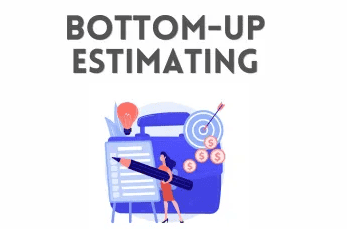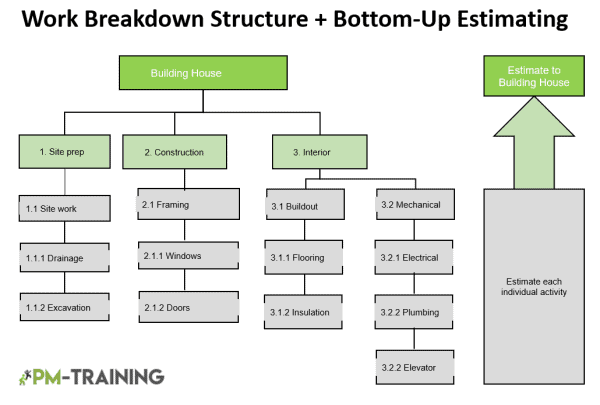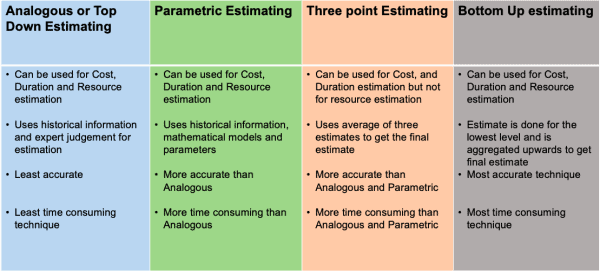Bottom-Up Estimating in Project Management

Bottom-up estimating is an essential project management technique. It is used to estimate the project cost, duration, or resources. It starts by gathering the details at the lowest level of the work breakdown structure and estimating work for each work package. The estimate of the entire project is the sum of (cost, duration, or resource ) for each work package.
In this article, we will learn about the bottom-up estimate process and its advantages and disadvantages in project management.
It would be unreasonable to say how long it will take to write a whole book without considering the time required to complete each activity. Therefore, the book’s contents are decomposed into chapters, paragraphs, sentences, and even words. Each discrete unit’s duration (and hence cost) is estimated, and then the quantities are added to give an estimate for writing the entire book.
The point is that activities can be decomposed into smaller tasks to make estimating easier. Since bottom-up estimating requires decomposition and aggregation, two techniques must be considered.
During Bottom-up estimation, the project team takes ownership of the activities, ensuring that all components are considered for analysis. The project manager can comprehensively understand each work package, which also helps in risk identification and reduction in overall project risk.
Why Bottom-Up Estimation in Project Management is Important
Using this estimation method, you must first understand that the project has duration and cost constraints predefined chiefly defined in the project charter. You must thoroughly analyze and evaluate everything required to complete the project within the constraints. It is essential to have a well-defined work breakdown structure to implement this technique successfully.
The bottom-up estimation method is often used in project management because it is the most reliable technique for estimating cost, duration, and resources. It is most reliable because the project is divided into smaller parts, each evaluated independently. Since each part is independently assessed, this estimation technique is the most time-consuming yet, the most accurate
How to do bottom-up estimating
Bottom-up estimating is used to estimate project cost, duration, or resource needs. These estimates are interdependent, as duration is directly related to the resources assigned to the work, and costs depend on time and resource requirements. So, how do you do bottom-up estimating? As per the PMI methodology, bottom-up estimating involves two important processes: creating WBS and defining activities.
Create a work breakdown structure or WBS
First, you’ll need to create your work breakdown structure, or WBS, to estimate the time/cost required for each step in the process. Work breakdown structure examples are often made using the mind mapping technique, which helps you better visualize how the project will be completed. Under each step, you will list all the tasks that need to be completed so that the overall project can be considered complete. At this point in your estimating process, including all the resources you expect will be needed for each work package is a good idea.
Determine Resource and timeline
Bottom-up estimating estimates the number of resources needed to complete a project. It usually starts by assigning tasks from the work breakdown structure (WBS) to team members, and then the resource estimates the time/ cost required for each study. Considering the expertise, knowledge, and skill required to complete each task is essential. Therefore, the team leader is often involved in this process.
Delegate estimating to the team
During this step, the RACI chart or RAM is often used to assign the task to the team, enabling the team members to estimate the actual time/cost to complete various tasks rather than relying on an assumption. The process can be tedious; therefore, you want to delegate this responsibility to the team member who is most familiar with the work.
To charge estimating to a team member, you need two essential components: the task and the person who will do the estimating. First, identify and break down all of the tasks into smaller subtasks. This process of decomposition is known as decomposition.
Next, decide who will do the decomposing or estimation for each sub-task. There are several estimating techniques. One method estimates each person’s time to do a particular subtask. Another way is to create a single detailed plan and then split it among the team members. The third option is to assign time to an entire subtask (or set of subtasks) and let everyone work on their assigned tasks at their rates and times.

Aggregate team estimates
After assigning the activity to the resources using the RAM (Responsibility Assessment Matrix), such as the RACI chart, the estimates for each activity are documented. Expert judgment, lead and lags, and reserve analysis help estimate the duration, cost, and resource requirements. It is also essential to create the basis of estimates for risk identification and integrated change control.
On completion of bottom-up estimation, the process results in cost estimates, duration estimates, or resource requirements.
Bottom estimation example
The cost and duration of a construction project estimated using bottom-up estimating are determined by dividing the work into small work packages. For instance, the construction of a house project can be divided into work packages such as Architectural design, excavation, foundations, walls, windows, paint, flooring, electricity, heating, plumbing, etc. These work packages are further divided into individual activities.
After the activities are defined, each activity’s cost and duration are determined and rolled up to the work package and the deliverable level. The aggregated value of time and cost helps in the estimation.
Recommended article: Bottom-Up vs Top-Down vs Parametric Estimating
Bottom-up estimating or Top-down
The top-down estimating approach is usually used during the initial project stage. The cost and duration estimate for deliverables are determined before the deliverables are divided into work packages and activities. This approach is also preferred when working on repeated projects, as the process has already been established for repeated projects. In contrast to bottom-up estimates, this process is fast but less reliable.
For instance, if the new project is similar to a previous project done by the organization, then the estimate for the latest project can be calculated using the estimates from the earlier projects. The cost of the last project was USD 100,000, so the forecast for the new project would be 100,000 if a similar amount of work is required.

Bottom-Up vs Parametric Estimating
Parametric estimating is a statistical-based technique in which the relationship between the variables is used for an accurate estimate. It usually requires extra information when using a PERT formula or calculation algorithm. For example, if a wall of area 100 Square feet is to be painted and the cost of painting each square foot is $5, then the total estimated cost would be 100*5 = $500. Therefore, the parametric estimation is based on a mathematical model.
The parametric estimating technique is easy to demonstrate and fact-based, so getting estimates approved by the stakeholders is easy. Once the variables and the mathematical model are developed for the project, the models can easily be used in similar projects.
However, the parametric technique requires reliable historical information; therefore, if the historical data is not available or reliable, this technique cannot be used. It is also essential to build an accurate model to determine project estimates. Any error in the model can result in inaccurate estimates, which will, in turn, result in project failure.
Bottom-up vs Three-point Estimating
The three-point estimation technique is the average of three estimates, namely the optimistic estimate, the pessimistic estimate, and the most likely estimate. This technique can be used to estimate the cost and duration of a project, and it is more accurate than the Analogous and Parametric estimating techniques. The optimistic estimate is the best-case scenario; the pessimistic is the worst-case scenario, and the most likely is the most realistic scenario. Subject matter expertise is essential in this method.
E = (O + M + P) / 3
Where “O” is optimistic, “M” is most likely, and “P” is pessimistic
The PMBOK uses t(E), t(O), t(M), and t(P) as variables for time estimates, and c(E), c(O), c(M), and c(P) as variables for cost estimates.
Example of a three-point estimate
| Optimistic Estimate | 11 Days |
| Pessimistic Estimate | 20 Days |
| Most Likely Estimate | 14 Days |
Example of a three-point estimate
Three-point estimate = ( 11 + 20 + 14) / 3. This results in the final estimate of 15 days.
Pros & Cons of Bottom-up Estimating
Advantages of bottom-up estimating in project management
- The bottom-up analysis is the most accurate technique because the team member responsible for the task is involved in the estimation process. This technique can also be used in combination with other estimating techniques.
- The Bottom-up estimating technique helps reduce the risk of cost and duration overrun by providing accurate estimates, increasing the project success rate.
- The bottom-up estimation technique is significantly helpful in projects that are new to the organization or in projects for which no historical information is available
Disadvantages of bottom-up estimating in project management
- Even if reliable historical data is available for estimation, the bottom-up estimating technique requires estimating each activity; therefore, it is not scalable.
- It is the most time-consuming technique; therefore, it is not helpful in repeated projects or organizations with a high-volume project load.
- Bottom-up estimates require proper planning and time, so they cannot be used in projects with duration constraints.
FAQs
How do you calculate bottom-up estimates?
Bottom-up estimating is relatively straightforward but requires a lot of time and work. The WBS is created, activities for each work package are defined, and the team member responsible for the activity does the estimation. The estimation process is repeated for each work package, and the total estimate for the entire project is the sum of the estimate of each work package.
Which method of estimating is the most accurate?
The most accurate method of estimation is the Bottom-up approach.
What is the most popular method of estimation?
The most popular estimation methods are Analogous estimating, parametric estimating, three-point estimating, PERT analysis, and bottom-up estimating. The technique used in the project depends on the historical information available, risk appetite, cost, and duration constraints.
What are the 6 techniques of estimation?
The six techniques of estimation include Top-down estimation, Bottom-up estimation, Parametric estimation, PERT formula, 3-point estimation, Cost of Delay Estimation by Analogy


